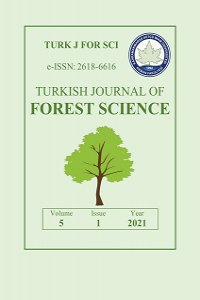YÜKSEK YOĞUNLUKLU POLİETİLEN BAZLI POLİMER KOMPOZİTLERİN BAZI ÖZELLİKLERİ ÜZERİNE ATIK ÇAY ODUNU LİFLERİ VE MAPE’NİN ETKİSİ
Odun-plastik kompozit, lignoselülozik materyal atık çay odunu kimyasal analizi, Camellia Sinensis, enjeksiyon kalıplama.
EFFECT OF WASTE TEA (CAMELLIA SINENSIS) WOOD FIBERS AND MAPE ON SOME PROPERTIES OF HIGH DENSITY POLYETHYLENE (HDPE) BASED POLYMER COMPOSITES
Wood- plastic composite lignocellulosic material, chemical analysis of waste tea wood, Camellia Sinensis, injection molding,
___
- Chaharmahali, M., Mirbagheri, J., Tajvidi, M., Najafi, SK. & Mirbagheri, Y. (2010). Mechanical and physical properties of wood-plastic composite panels. J Reinf Plast Comp. 29: 310–319.
- Chan JH & Balke ST. (1997). The thermal degradation kinetics of polypropylene: Part III. Thermogravimetric analyses. Polym Degrad Stabil 57: 135–149.
- Coutinho, F.M.B., Costa, T.H.S. & Carvalho, C.D.L., (1998). Effect of treatment and mixing conditions on mechanical properties. Polypropylene-wood fiber composites: J. Appl. Polym. Sci. 65, 1227- 1235.
- Demir, H., Atikler, U., Balkose, D. & Tihminlioglu, F. (2006). The effect of fiber surface treatments on the tensile and water sorption properties of polypropylene–luffa fiber composites. Compos Part A. 37: 447–456.
- Kaboorani A.(2010). Effect of formulation design on thermal properties of wood/thermoplastic composites. J Compos Mater 44: 2205–2215.
- Klyosov, AA. (2007). Wood-plastic composites, 1st ed. Wiley Interscience: Hoboken, New Jersey, USA
- La Mantia FP, Morreale M & Izhak ZA. (2005). Processing and mechanical properties of organic fillerpolypropylene composites. J Appl Polym Sci 96: 1906–1913.
- Lai, S. (2003). Comparative study of maleated polyolefins as compatibilizers for polyethylene/wood flour composites. J. Appl. Polym. Sci. 87, 487-496; DOI 10.1002/app.11419.
- Li, Q. & Matuana, L.M. (2003). Effectiveness of maleated and acryclic acid-functionalized polyolefin coupling agents for HDPE-wood-flour composites. J. Thermoplast. Compos. 16, 551-564; DOI 10.1177/089270503033340.
- Liu, H., Wu, Q. & Zhang, Q. (2009). Preparation and properties of banana fiber-reinforced composites based on high density polyethylene (HDPE)/Nylon-6 blends. Bioresource Technol. 100: 6088–6097.
- Mengeloglu, F. & Karakus, K. (2008). Polymer-composites from recycled high density polyethylene and waste lignocellulosic materials. Fresen Environ Bull. 17: 211–217.
- Mengeloglu. F. & Kabakci, A. (2008). Determination of thermal properties and morphology of eucalyptus wood residue filled high density polyethylene composites. Int J Mol Sci. 9: 107–119.
- Mengeloglu, F., Matuana, LM. & King, J. (2000). Effect of impact modifiers on properties of rigid PVC/ wood-fiber composites. J Vinyl Addit Techn. 6: 153–157.
- Nunez AJ, Sturn PC, Kenny JM, Aranguren MI, Marcovich NE & Reboredo MM. (2002). Mechanical characterization of polypropylene-wood flour composites. J Appl Polym Sci 88: 1420–1428.
- Panthapulakkal, S. & Sain, M. (2007). Agro-residue reinforced HDPE composites: Fibre characterization and analysis of composites properties. Compos Part A. 38: 1445–1454.
- Sain M & Panthapulakkal S. (2006). Bioprocess preparation of wheat straw fiber and characterization. Ind Crop Prod 23: 1–8.
- Sombatsompop, N., Yotinwattanakumtorn, C. & Thongpin, C. (2005). Influence of type and concentration of maleic anhydride grafted polypropylene and impact modifiers on mechanical properties of PP/Wood sawdust composites. J. Appl. Polym. Sci. 97, 475-484; DOI 10.1002/app.21765.
- Stark N & Berger MJ. (1997). Effect of species and particle size on properties of wood-flour-filled polypropylene composites, In: Sypmosium of Functional Fillers for Thermoplastics and Thermosets, San Diego, California. pp.1–20.
- Stark, M. & Rowlands, RE. (2003). Effects of wood fiber characteristics on mechanical properties of wood/polypropylene composites. Wood Fiber Sci. 35: 167–174.
- Tea sector report (2019). General Directorate of Tea Enterprises. Taken from address https://www.caykur.gov.tr/Pages/Yayinlar/YayinDetay.aspx?ItemType=5&ItemId=721 on 2 September 2021
- Yang, H.S., Wolcott, M.P., Kim, H.S., Kim, S. & Kim, H.J. (2007). Effect of different compatibilizing agents on the mechanical properties of lignocellulosic material filled polyethylene bio-composites. Compos. Struct. 79, 369-375; DOI 10.1016/j.compstruct.2006.02.016.
- Yao, F., Wu, Q., Liu, H., Lei, Y. & Zhou, D. (2011). Rice straw fiber reinforced high density polyethylene composite: Effect of coupled compatibilizating and toughening treatment. J Appl Polym Sci. 119: 2214–2222.
- Wang, Y., Yeh, F.C., Lai, S.M., Chan, H.C. & Shen, H.F. (2003). Effectiveness of functionalized polyolefins as compatibilizers for polyethylene/wood flour composites. Polym. Eng. Sci. 43(4), 933-945; DOI 10.1002/pen.10077.
- Yayın Aralığı: Yılda 2 Sayı
- Başlangıç: 2017
- Yayıncı: Kahramanmaraş Sütçü İmam Üniversitesi
Gonca DÜZKALE SÖZBİR, İbrahim BEKTAŞ, Ayşenur KILIÇ AK, Saniye ERKAN
Deniz ÖZBEY, Aslı GÜNEŞ GÖLBEY
NECİP FAZIL KISAKÜREK PARKI İÇİN BİR WEB UYGULAMASI, KAHRAMANMARAŞ, TÜRKİYE
Milat Hasan Abdullah ABDULLAH, Hakan OĞUZ, Fatih TONGUÇ
BİRİNCİL VE İKİNCİL LİFLERDEN OFİS KAĞIDI ÜRETİMİ ÜZERİNE BİR ARAŞTIRMA
COVID-19 KAPSAMINDA AÇIK VE YEŞİL ALAN TASARIM ÖNERİLERİ: EFELER/AYDIN ÖRNEĞİ
İsa BOZAN, Erol YILDIRIMVURAN, Ebru ERSOY TONYALOĞLU
FARKLI ARAZİ KULLANIM ŞEKİLLERİNİN BAZI TOPRAK ÖZELLİKLERİ ÜZERİNE ETKİLERİ
Mahmut REİS, Bülent ABIZ, Seda ATAŞ, Seda TAT
İlkay ATAR, İbrahim Halil BAŞBOĞA, Kadir KARAKUS, Fatih MENGELOĞLU
Fraxinus angustifolia Vahl. PLANTASYONLARINDA BÜYÜME PARAMETRELERİ ÜZERİNE SIKLIK BAKIMININ ETKİSİ
Deniz GÜNEY, Fahrettin ATAR, İbrahim TURNA, Ali BAYRAKTAR, Alkan GUNLU
